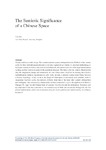Mostrar o rexistro simple do ítem
The semiotic significance of a Chinese space
| dc.contributor.author | Jin, Fan | es_ES |
| dc.date.accessioned | 2014-10-02T12:31:18Z | |
| dc.date.available | 2014-10-02T12:31:18Z | |
| dc.date.issued | 2012 | es_ES |
| dc.identifier.citation | Culture of communication / Communication of culture, 2012: 251-257. ISBN: 978-84-9749-522-6 | es_ES |
| dc.identifier.isbn | 978-84-9749-522-6 | es_ES |
| dc.identifier.uri | http://hdl.handle.net/2183/13315 | |
| dc.description.abstract | [Abstract] Human world is a world of sign. The western semiotic system corresponds to the Weltbild of the western world. Its basic methodological principle is not only significant as a theory of universal methodology of the human science, but also a simulacra of the Lebenswelt, the unconscious part of the huge consciousness building, and the interior structure of the superficial structure. The form is the real content. Based on this idea, the imagination, design and construction of a real China-space, which on the contrary has a kind of methodological, technical significance as well, imply not only a semiotic system about China, but even a Chinese Semiology. In fact, as far as the design of China-space is concerned, some scholars’ mode of imagination has been subtly, but radically different from that of the most other western philosophers and sinologists. One common key characteristic of their construction ways is the application of Book of Changes (Yi Jing), the old Chinese book of wisdom. Can this provide the professional Semiotics with any inspiration? Can this contribute to our reconstruction of faith and community feeling after the flux of postmodernization which aims at deconstructing the fixed world picture represented by the orthodox Semiotics? | es_ES |
| dc.language.iso | eng | es_ES |
| dc.publisher | Universidade da Coruña | es_ES |
| dc.title | The semiotic significance of a Chinese space | es_ES |
| dc.type | info:eu-repo/semantics/conferenceObject | es_ES |
| dc.rights.access | info:eu-repo/semantics/openAccess | es_ES |






